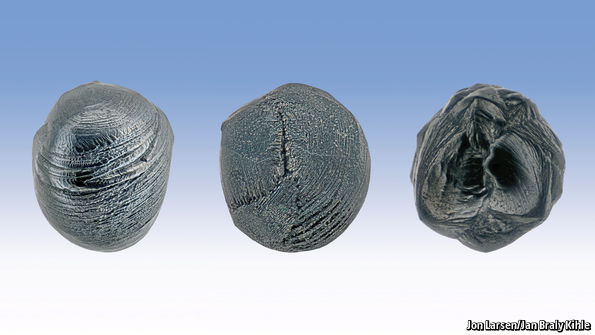ABOUT 4.6bn years ago, a spinning disc of gas and dust began to coalesce into balls of matter. The largest sphere, at the disc’s centre, collapsed under its own gravity to form the sun. Other clumps of dust, scattered around its periphery, became planets and asteroids. In planets, this dust has long-since metamorphosed into rock. But in many asteroids, it is still more or less intact. As a consequence, when asteroids collide, some of it is liberated—and a small fraction of that material eventually falls to Earth as micrometeorites. This micrometeoritic dust arrives at a rate of around six tonnes a day. Spread over Earth’s surface, that amounts to just one particle per square metre each year.
Researchers go to great lengths to gather these grains, because they can reveal details of the solar system’s composition and history. They normally collect them by dredging up ooze from the ocean bed, then sifting and filtering it to find a few precious particles, or by melting tonnes of ice from the Antarctic to see what precipitates. Those two locations have the advantage of being isolated and reasonably free of dust from industrial sources. Now, in a study just published in Geology, a group of researchers have identified about 500 micrometeorites from an unlikely source: gutter sediment from the roofs of buildings in two of Europe’s capital cities.
Enthusiastic amateur astronomers have claimed to have found cosmic dust in such urban slurry before. Professional scientists, however, tend to be sceptical of such claims, and none has been verified. Jon Larsen, a Norwegian musician, refused to be discouraged. He collected detritus from gutters in his hometown, Oslo, and also from rooftops in several cities that he visited to play jazz or to attend conferences. Micrometeorites contain magnetite, a naturally magnetic form of iron oxide, commonly known as lodestone.
Mr Larsen’s first step was therefore to pass his slurry, about 300kg of it, past a magnet and keep anything that stuck. He then examined the 30kg or so of debris that resulted under a microscope, to hunt for cosmic dust. Micrometeorites melt as they zip through Earth’s atmosphere at speeds of around 12km a second. The globules then cool into spherical grains, and the minerals of which these are composed take on a distinctive stripy appearance (see picture). An experienced eye, such as Mr Larsen’s, can thus pick them out from other particles, which tend to be jagged and lack these markings. Altogether, he found about 500 of these “spherules”, each around 300-400 microns in diameter (a few times the width of a human hair).
To confirm that the spherules were indeed micrometeorites Mr Larsen needed both expertise and more heavyweight equipment than he had at home. He therefore turned to Matthew Genge of Imperial College, London and his colleagues. They analysed 48 items from Mr Larsen’s Oslo and Paris collections under a scanning electron microscope. They were able to confirm that the composition of these matched that of micrometeorites, which tend to be rich in olivine, a greenish semi-precious gemstone. Most tellingly, Mr Larsen’s samples contained iron and nickel alloys common in micrometeorites, but rare in Earth-bound rocks because these metals oxidise rapidly.
Micrometeorites dredged from the sea may have fallen to Earth any time within the past 50,000 years or so, depending on the depth of sediment recovered. Likewise, those found in Antarctic ice may have arrived up to a million years ago. In both instances the recovery technique mixes old and new, so it is impossible to identify specimens that have arrived in the past few decades. Some of the micrometeorites Mr Larsen has collected, on the other hand, must have touched down less than six years ago, because the gutters they came from were cleaned then.
Intriguingly, these recent arrivals are more densely striped than an average specimen plucked from Antarctica or the ocean floor. That, Dr Genge says, suggests that they arrived at particularly high velocity. The speed with which they hit the atmosphere is dictated by the combined gravitational forces on them of the solar system’s planets. That they are apparently arriving faster now than in the past may be because the planets’ orbits are in slightly different positions relative to each other than they were a million years ago.
That is to be expected. Planetary orbits are elliptical, rather than circular, and their gravitational interactions with one another may cause the shapes of these ellipses to change over the years. On Earth, such changes are believed to contribute to the waxing and waning of ice ages. If micrometeorites could be collected from conventional sources in ways that recorded when they had arrived, that might aid understanding of similar changes in the orbits of other planets.
Even if this proves difficult, Dr Genge and Mr Larsen hope the guttering of the world’s roofs will prove a useful third source of micrometeorites for general study. Oscar Wilde once wrote, “We are all in the gutter, but some of us are looking at the stars.” Little did he suspect that looking in the gutter itself would also yield a little of the stuff from which stars are made.





